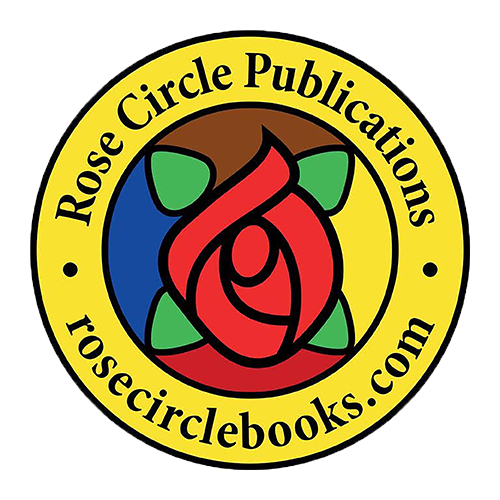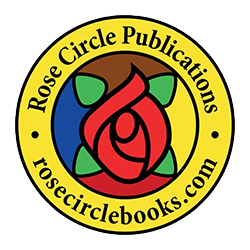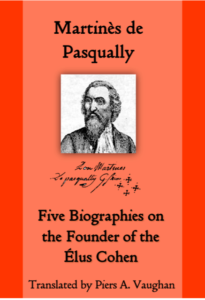
Martinès de Pasqually Five Biographies on the Founder of the Élus Cohen – translated by Piers A. Vaughan
Martinès de Pasqually was the enigmatic and secretive founder of the Ordre des Chevaliers Maçons Élus Coëns de l’Universe, a theurgical Order which appeared briefly on the scene in France in the late 18th Century, and fell apart a very short time later. Despite its brief life, it has garnered much attention in recent years, and increasingly extravagant (and unproven) claims have been by various groups to be the only ones in possession of ’secrets’. Even the current Wikipedia entry pompously tells us anglophones that to call the Order the ‘Elus Cohens’ instead of the ‘Élus Coëns’ is incorrect – though the last time I checked the English language didn’t have accents, and the word used in the Bible for Hebrew priests is ‘cohen’!
In an attempt to bring some grounding to the situation, the author has selected five of the most important biographers of Pasqually and his Order and translated their works into English, providing a resource whereby readers can make up their own minds about this colorful character. In his biography on Pasqually, Dr. Gerard Vanrijnberk cited the most important as being those by Papus, René Philipon, Vuillard, and René Le Forestier. This book contains those writings, as well as that of Dr. Vanrijnberk.
The authors vary considerably in their approach to Pasqually, from virtual hagiography (Papus) to extreme cynicism (Vulliaud), with more balanced offerings from the historians. The works are present in chronological order, so that the reader may appreciate how each draws from his predecessors’ works while adding his own discoveries and interpretations.
Release date: Spring 2021
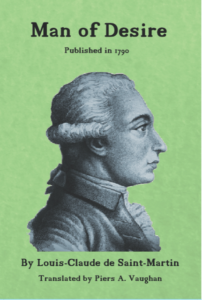
Man of Desire (1790) by Louis-Claude de Saint-Martin – translated by Piers A. Vaughan
This extraordinary book was written by Saint-Martin around the time he was beginning to encounter the works of Jacob Boehme, and he began writing it during a stay in England, completing the book in Paris. Because of this, we can state that it is probably the last book which reflected Saint-Martin’s ideas alone, prior to becoming deeply fascinated by the works of Boehme, an influence on which A. E. Waite commented: “…the influence of the Teutonic Philosopher upon all his later life and all his thoughts may be found on too many pages of his latest works.” This can also be seen by the fact that, between the first and section editions of the book, the following passage had been added to Chapter 97: “ According to Jacob Boehme, the human soul produces the seed or essence of spirit, and not the spirit fully formed. Ponder his doctrine, for it appears to reconcile the difficulties well.” This was the only reference to Boehme in the book.
The book itself is composed of 301 chapters or sections. Robert Amadou poetically refers to them as ‘Chants’, meaning songs, chants, even poems. In fact, the original book simply gave each section a number. However, in a way, Amadou’s lyrical approach suits these verses well, for this isn’t a book with chapters and a flowing narrative. In a way, they read more like Psalms: one person used the term Scriptures. It is almost impossible to read them as purely academic or factual exercise, for they inspire meditation which is their purpose. And when we allow the words to flow and the music of their message to penetrate us, we begin to see why, for example, Waite called this book: “the most exalted and inspired of his compositions.”
Release date: Spring 2021
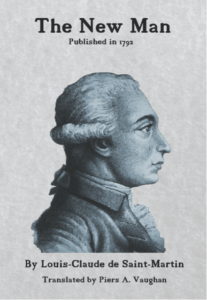
The New Man (1792) by Louis-Claude de Saint-Martin – translated by Piers A. Vaughan
By this point, Saint-Martin was now an avid disciple of Boehme’s works and the Teutonic Philosopher now colors his philosophy. And yet we still see the same Saint-Martin shining through the arguments and the images. Saint-Martin himself traced the Path of Reintegration through a number of perceptible stages, beginning at the moment when the person realized there was more to life than ‘going through the motions’, beginning to realize that the imprint of the Creator could be seen in everything in the universe, as they began to come out of the Forest of Errors and begin their new journey as a Man or Woman of Desire. The next stage of their journey, if the former was an apprenticeship, sees these seekers beginning to understand their mission and duty, and willingly reorient their lives towards the desired goal of Reintegration or return to their Source. Now they are journeymen or New Men and New Women, having begun to shed the first vestiges of the physical attractions which bound them to the material world.
Under the allegory of Truth, God seeks to enter into a new covenant with man, but only once man can distinguish that which is earthbound within him and can separate the divine from the physical, in order to attain this wonderful union. For the heart of man is where the Prime Cause wishes to reestablish His sanctuary, and there must man, like the Vestals of old, maintain his sacred fire. While in the previous bookman was referred to as the Man of Desire, here he is called the New Man, to represent his advancing state of development. Now Saint-Martin turns his face forward to contemplate the future, rather than pouring scorn upon the works of his predecessors and contemporaries who he called the ‘Observers’, or the agnostics, atheists, and Encyclopedists. The book is laid out in a more flowing style, and ends with the wonderful words of promise: “and finally, all the wonders of the Heavenly Jerusalem may still be found today in the heart of the New Man since they have existed there from the beginning.”
